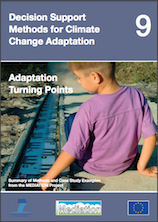Adaptation Turning Points
This article, which is part of a series of MEDIATION outputs, discusses the specific situation where climate change induces policy failure and alternative strategies have to be considered. We term these kinds of situations Adaptation Turning Points.


Key Messages
- Concerned decision makers increasingly ask whether current management is able to cope with climate change or whether alternative strategies are needed. They urgently demand tools to assess and communicate the implications of climate change and opportunities for adaptation.
- The European MEDIATION project has undertaken a detailed review of methods and tools for adaptation, and has tested them in a series of case studies. It has assessed their applicability for adaptation and analysed how they consider uncertainty. The findings are summarised on the MEDIATION Adaptation Platform and in a set of Policy Briefing Notes.
- The method presented in this Policy Briefing Note focuses on the specific situation where climate change induces policy failure and alternative strategies have to be considered. If such a situation is thinkable, there is an imperative to act and climate change becomes particularly relevant to decision makers. We call this situation an ‘adaptation turning point’.
- The assessment of adaptation turning points translates uncertainty about the magnitude of climate impacts into a time range over which it is likely that an unacceptable situation occurs. This time range can be used to adapt.
- Knowledge on adaptation turning points helps to combine potential adaptation measures into adaptation pathways. Adaptation pathways encourage taking short-term actions to sustain the current system, whilst planning longer-term adaptation that may be required in the future.
- Practical experience shows that the assessment of adaptation turning points allows for a meaningful dialogue between stakeholders and scientists about the amount of change that is acceptable, when conditions could be reached that are unacceptable or more favourable, how likely these conditions are and what adaptation pathways to consider.
- The main strength of assessing turning points for adaptation is that the approach is highly policy-orientated, and uses scenarios to delineate uncertainties in time. It is also very flexible and can consider a range of objectives, which encourages discussion on acceptable change and critical values. Weaknesses relate to a potential focus on existing objectives, rather than new challenges. In addition, simplicity is lost when thresholds are less-well defined and when turning points have multiple drivers.
- Summarising, an assessment of adaptation turning points focusses on the specific threshold situation that policy becomes untenable due to climate change. The assessment translates uncertainty about climate impacts into a time range that can be used to plan adequate responses. Adaptation pathways offer flexibility by allowing for progressive implementation.
Suggested Citation
Werners et al. (2013). Adaptation Turning Points: Decision Support Methods for Adaptation, MEDIATION Project, Briefing Note 9.
The research leading to these results has received funding from the European Community’s Seventh Framework Programme (FP7/2007-2013) under grant agreement no. 244012.
(0) Comments
There is no content